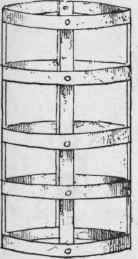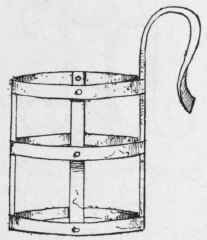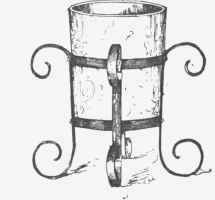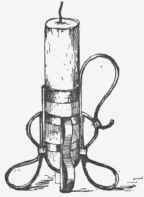Hanging Hooks
Description
This section is from the book "Elementary Metal Work", by Charles Godfrey Leland. Also available from Amazon: Elementary Metal Work.
Hanging Hooks
The simplest useful object which can be made is a hanging hook. This must be made of rather thick sheet iron. Curve one end and drill a large hole in the other, to receive the nail in which it is to hang. But as it will swing to one side or the other, it is better to drill two holes, and use two nails. It may be improved in appearance by making a cross, or a triangle of three straight strips on which it may be riveted, Fig. 20. It may be here remarked that brass, copper, or silver-headed tacks may often be used for rivets, to improve the general appearance of many objects.
To make a useful and very simple cylindrical holder, take one strip of from one foot to eighteen inches in length, and make two or three rings as previously described in Lesson I. Rivet them together with uprights as shown in Fig. 21. Rivet one straight strip across the bottom. It may be still further improved by adapting to it a handle, Fig. 22. These constructions may be very much varied, so as to contain cylinders to hold spills of paper lead pencils, pens or inkstands, or small bottles of ink, tumblers or lamps. Their appearance may be improved by making the rings of strips of sheet brass, copper or red metal.

Fig. 21.

Fig. 22.

Fig. 23. Card Tray.
Take four strips each eighteen inches in length. Bend the ends of all and cross them, so that two may turn under downwards, and two upwards. A single rivet will hold the four. Fit a saucer into the upper cross, and you will have a pretty card-tray, Fig. 23.

Fig. 24. Tumbler Stand.

Fig. 25. Wooden Bowl on Iron Stand.

Fig. 26. Glass Flagon on Stand.

Fig. 27. Candlestick.
If we have a cup or a goblet, or small bottle of any shape whatever, we have only to draw its outline on paper, and with a little ingenuity adapt strips to it to make a holder. Many objects of glass or porcelain which have had their supports broken away, can thus be utilized. See Figs. 24-27.1
It is sometimes impossible to rivet in the manner previously described, by a direct blow on the head of the rivet or nail, owing to the closeness of the strips. In such a case, if it cannot be crushed with strong flat nippers, take one very large nail or a small square bolt, also a piece of hard wood, which will pass through and form a rest. Screw the latter into the vice, and drill or drive the hole upon it; in most cases you make it from either side straight enough. Then put in the rivet, and, covering it with the nail or bolt, give the latter a hard blow close to the strip.
But in most cases such close strips, especially of thin 1/8 in. iron, are bound by means of wire or clamps, before described, which are small pieces of thin iron wrapped closely round the two strips, their edges just meeting and then punched together.
When wiring is to be done, it may be a single ring with a twist of the two ends, which suffices for ordinary work. But for a better effect, especially if brass or copper wire be used, first make the rivet hole, then pass the end of wire through it, wind it tightly with the pliers three or four times round the strips, twist the ends together, and pinch or hammer them flat.
Care should be taken to get a flexible wire, such as is used for bells; if it be brittle it is useless for such delicate work.
Let all the work be very neatly finished. Of late years an immense quantity of rudely made iron strip-work has been produced in Italy and sold very cheaply, with the result of greatly injuring the art.
Continue to:


